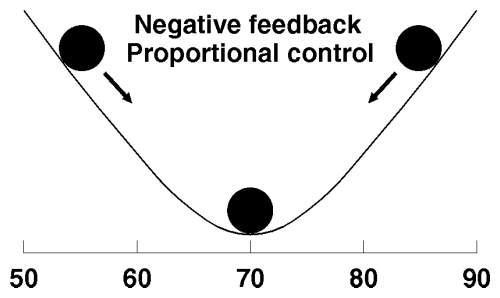Our thermostat, regardless of whether it's wired for negative or positive feedback, applies an all or nothing form of control. When the temperature drops too low, the furnace comes on, Hell bent, to heat up the place. When it gets too hot, the air conditioner's unleashed, flat out, to chill out the environs.
Engineers call this kind of control ``bang-bang.'' When it gets too cold bang, the furnace comes on. As soon as the temperature rises above 60° , bang the furnace cuts off. Too hot? Bang, the air conditioner starts, and so on.
Take a closer look at the inside temperature in the chart on page
![]() . See how the temperature tends to oscillate between
70 degrees and the level where the thermostat kicks in? That's the
signature of bang-bang control--since nothing happens until one of
the limits is hit, the temperature varies freely between them. When
the system exceeds a limit, it's hauled back within range, then
allowed to drift again.
. See how the temperature tends to oscillate between
70 degrees and the level where the thermostat kicks in? That's the
signature of bang-bang control--since nothing happens until one of
the limits is hit, the temperature varies freely between them. When
the system exceeds a limit, it's hauled back within range, then
allowed to drift again.
Bang-bang control keeps the temperature pretty much within the range from 60 to 80, but it allows the temperature to vary freely between the limits. Suppose instead of just switching the furnace and air conditioner on and off, we coupled the temperature reading to the gas valve on the furnace: the further the temperature falls below 70, the more heat the furnace generates. Likewise, as soon as the temperature rises above 70, the air conditioner starts, but we rig it to generate more and more cooling as the temperature rises. We'll end up with a system that behaves like this.

This is called proportional control. The action taken, the feedback, is in proportion to the degree the system diverges from the ideal point. Imagine you're driving down the road some lonely night. Proportional control is how you usually drive; every time you notice the car drifting a tiny bit to the left, you steer slightly to the right and vice versa. Bang-bang control would mean ignoring the steering wheel until the car crossed a lane marker line. Then you'd haul it in the opposite direction until the car was no longer outside the lane: exciting, perhaps, but not recommended.

If bang-bang negative feedback keeps the temperature ball on the flat
floor of a valley with steep sides (see the chart on page
![]() ), proportional control confines it to the
bottom of a smoothly sloped bowl. The slightest degree of motion away
from the optimal point, the bottom of the bowl, causes the ball to
roll upward. The further it deviates from the goal, the stronger the
force applied to restore it--back to the bottom of the bowl. A chart
of positive feedback with proportional control would simply flip the
bowl upside down: the temperature would remain stable only as long as
it stayed perched at the precise optimum point. To appreciate how
quickly proportional positive feedback gets out of hand, try balancing
a raw egg on top of a bowling ball.
), proportional control confines it to the
bottom of a smoothly sloped bowl. The slightest degree of motion away
from the optimal point, the bottom of the bowl, causes the ball to
roll upward. The further it deviates from the goal, the stronger the
force applied to restore it--back to the bottom of the bowl. A chart
of positive feedback with proportional control would simply flip the
bowl upside down: the temperature would remain stable only as long as
it stayed perched at the precise optimum point. To appreciate how
quickly proportional positive feedback gets out of hand, try balancing
a raw egg on top of a bowling ball.
Proportional control makes systems run smoother than bang-bang. Most biological systems are proportional, while many engineered and all too many political and social systems are bang-bang. As with negative and positive feedback, once you understand how proportional control lends stability to a system, while bang-bang tends to oscillate between the extremes, you'll recognise many examples of both kinds of control in everyday life.
By John Walker